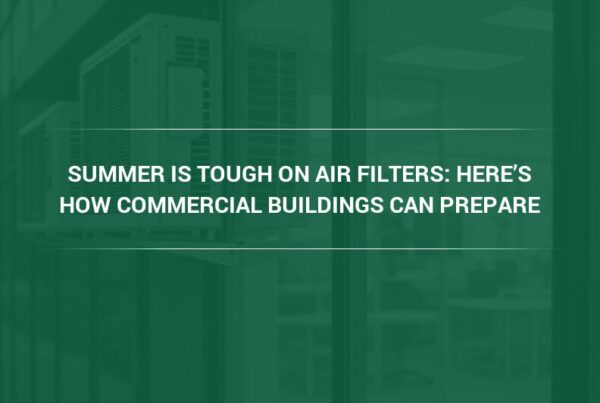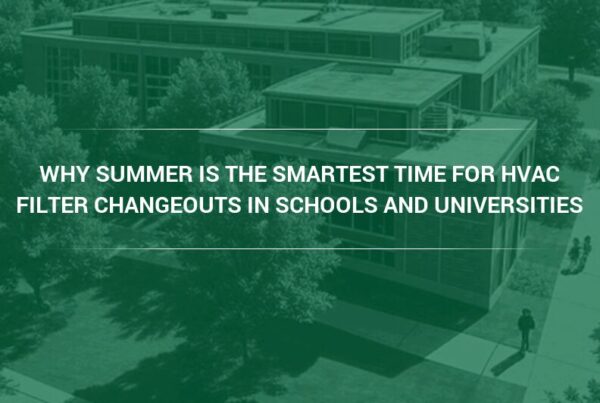Proper air filtration is essential in reducing and preventing the spread of infectious diseases through the different environments of a healthcare facility to improve patient outcomes.
Proper air filtration can improve patient outcomes by maintaining high indoor air quality (IAQ) and preventing the spread of disease among visitors and staff. Research indicates that high IAQ can improve patient recovery, especially for those with respiratory issues, and directly affects health and productivity.
However, several factors can jeopardize indoor air quality. External pollutants can enter indoor environments as individuals continuously enter and leave buildings. According to the U.S. Environmental Protection Agency (EPA), many common pollutants exist indoors in concentrations two to five times higher than typical outdoor levels.
Unhealthy patients can spread infectious diseases, while cleaning and therapeutic substances can emit chemical and biological compounds into the atmosphere. Facility renovations also introduce dust particulates into the air.
Many illnesses are caused or aggravated by poor IAQ. Therefore, air filtration is mandatory throughout hospital settings to remove airborne pathogens, dust particulates, and hazardous chemicals. This ensures a high level of air quality to safeguard patient health and healing.
Why Air Quality is Paramount in Healthcare Facilities
Healthcare facilities like hospitals face unique challenges when it comes to maintaining air quality. Patients with various infections often release respiratory droplets containing viruses when they cough, sneeze, or even talk. These droplets can infect others who breathe the same air, posing a significant risk to those with weakened immune systems.
Certain diseases, such as measles and tuberculosis, spread through airborne pathogens that can linger in the air for extended periods. For instance, the measles virus can survive in poorly ventilated areas. The virus can exist in the air for up to two hours after an infected person leaves the room. Individuals exposed to this contaminated air can become infected even without direct contact with the infected person.
Beyond pathogens, fine airborne particles like dust can exacerbate existing respiratory problems, making breathing more difficult. The EPA reports that exposure to these fine particles can lead to cardiovascular issues.
However, there’s good news: Studies show that high-quality indoor air in healthcare settings can promote patient recovery, reduce stress, and boost staff productivity. Cleaner air has less particles that could trigger respiratory conditions like asthma, making breathing easier for everyone.
To maintain optimal indoor air quality (IAQ), healthcare facilities adhere to various regulatory and compliance standards. For instance, the ANSI/ASHRAE/ASHE Standard 170-2021 Ventilation of Health Care Facilities provides guidelines for healthcare facility ventilation, including minimum filtration requirements for critical areas.
To comply with the intent of ASHRAE 170 minimum requirements and ensure safety in healthcare environments, Camfil recommends that facility directors insist on MERV-A values and request that a corresponding test report be supplied with every filter quotation.
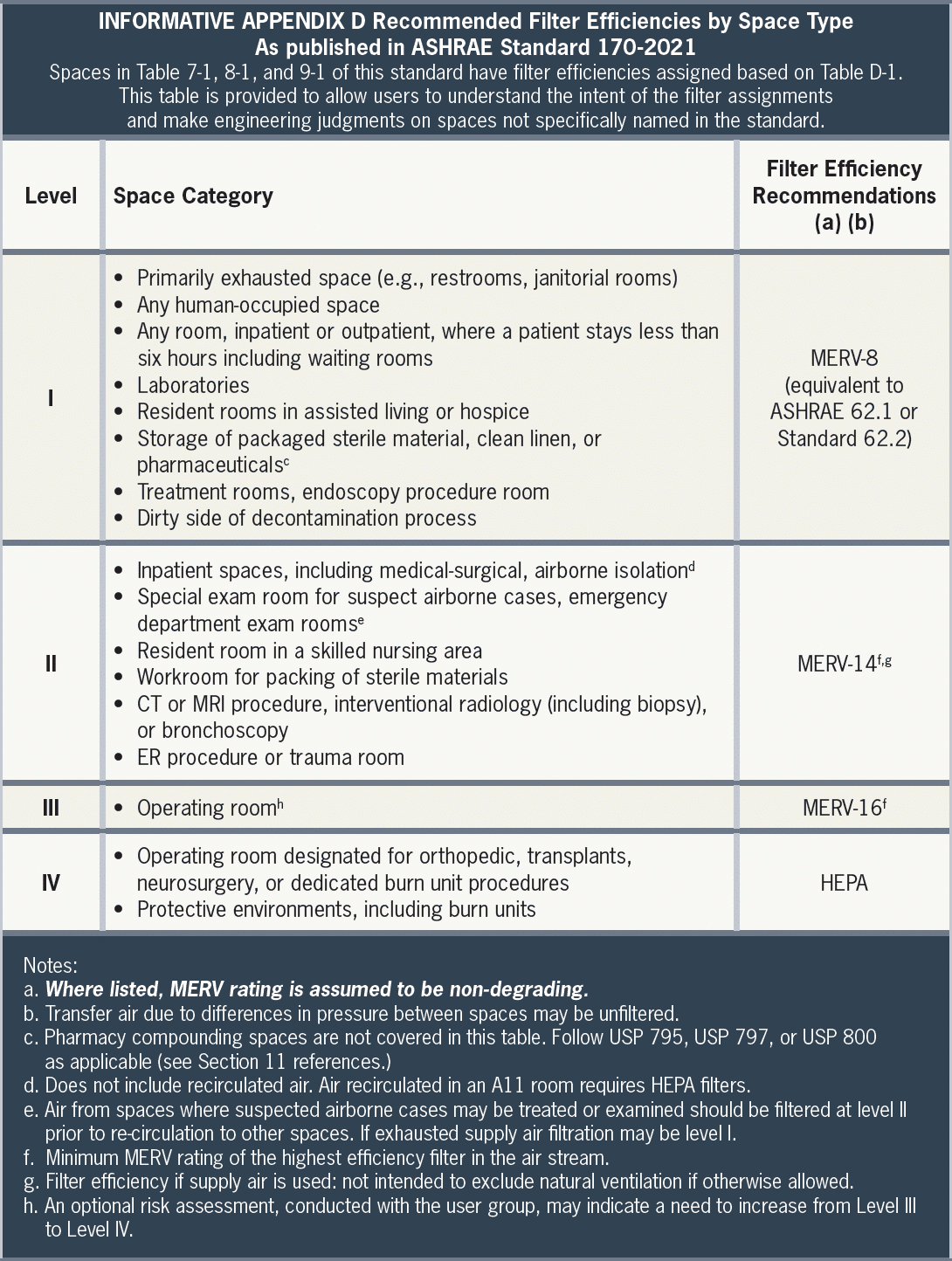
Similarly, the Centers for Disease Control (CDC) outlines recommendations for environmental infection control, specifying which types of air filters are most effective at removing airborne particles of different sizes.
Adhering to guidelines and best practices for air filtration helps to capture airborne particles efficiently, making the air safer and healthier for both patients and staff.
Key Hospital Zones that Require Filtration
The need for air filtration in a hospital varies based on factors like ventilation quality, room size, occupancy, and the types of medical procedures conducted. Below is a breakdown of air filtration recommendations within different areas of a hospital that can reduce the risk of infection. Filtration efficiency can vary according to the intended use of the space. Some spaces are required to have multiple stages of filtration such as prefilters followed by terminal filter housings.

Waiting Areas and Outpatient Care
Waiting areas and outpatient care spaces are not classified as critical for infection control, but they are often the first point of contact for individuals with undiagnosed illnesses. Airborne particles from coughs or sneezes can infect others in the room. Therefore, effective air filtration in these areas serves as an initial safeguard for both staff and other visitors.
Operating Rooms
In the operating room, patients are particularly vulnerable to infections, as surgical procedures often expose internal organs. High-efficiency filters are essential here for maintaining an ultra-clean environment, minimizing infection risks, and ensuring patient safety during surgery.
Camfil recommends the following HEPA filters for these areas as well as for discharge air from fume hoods or safety cabinets in which infectious or radioactive materials are processed.
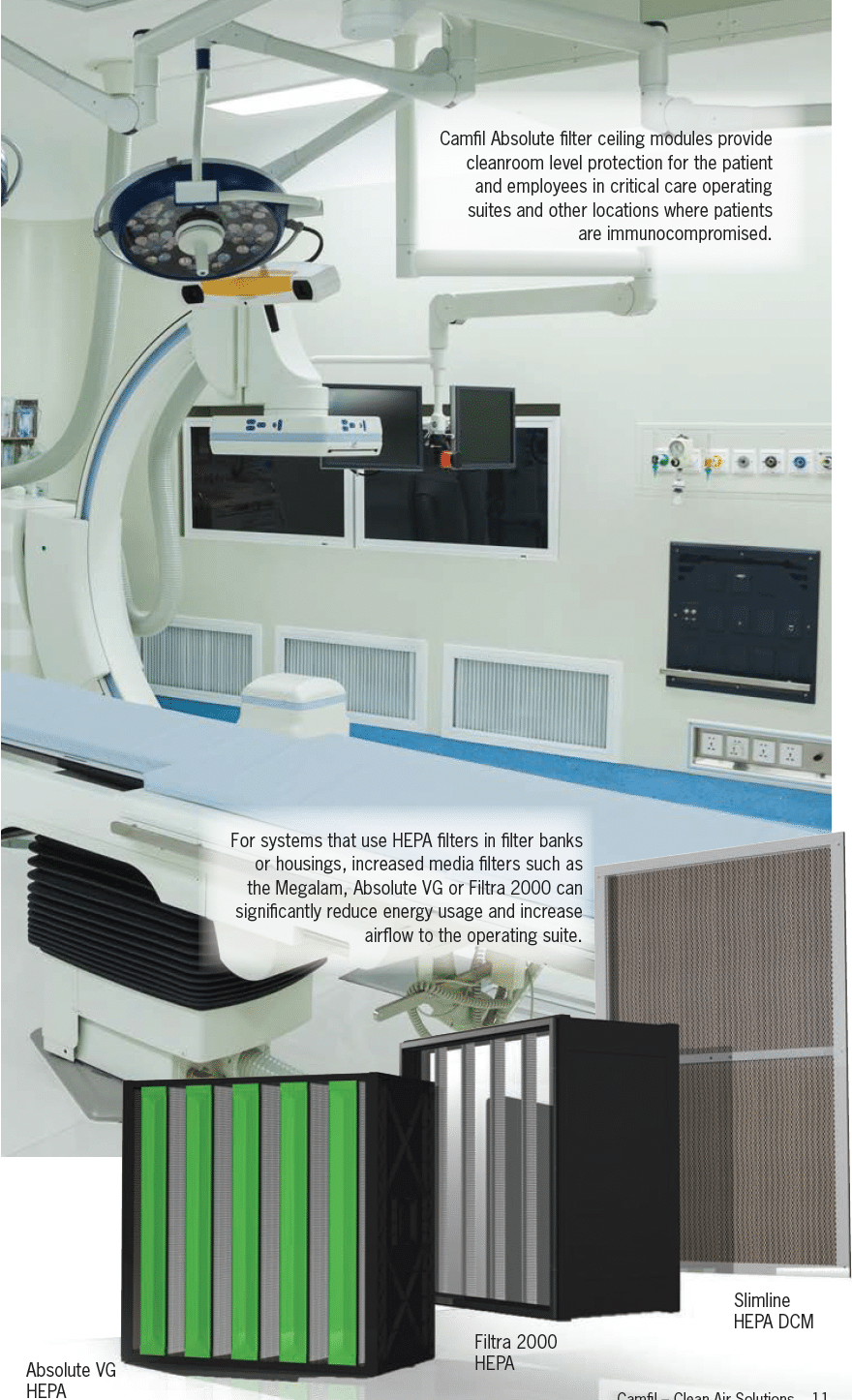
Nurseries
Newborns and infants are especially susceptible to airborne contaminants due to their underdeveloped immune systems. These areas require high standards of air purity to protect against potential airborne pathogens that could be lethal to young patients.
Patient Rooms
Rooms where patients are treated in close quarters can harbor infectious pathogens in the air. Factors like room configuration and ventilation impact how long contaminated air can linger before being replaced by clean air. Without effective filtration systems, staff, visitors, and patients risk exposure to airborne infections.
Pharmacies within Medical Facilities
Pharmacies, often located within hospitals, handle drugs, solvents, and chemicals that require a clean environment. Quality air filtration is crucial here to protect pharmacists and nurses from potential hazards associated with processing these substances.
Choosing the Best Air Filters for Healthcare Environments
Air filters play a crucial role in HVAC systems by capturing a range of particles, including pathogens, dust, and other contaminants, to maintain high indoor air quality. The air filters come in various technologies and efficiencies, each evaluated by a minimum efficiency reporting value (MERV) rating that ranges from 1 to 16 (See chart below). This rating helps to gauge a filter’s effectiveness at trapping particles.
For critical hospital areas, filters with MERV ratings of 14 or higher are usually recommended. These filters excel at capturing extremely fine particles—some as small as 1/300th the diameter of a human hair—helping to prevent the spread of bacteria and infectious diseases.
| MERV Rating | Average Particle Size Efficiency in Microns |
| 1 – 4 | 3 to 10 less than 20% |
| 5 | 3 – 10 less than or equal to 20% |
| 6 | 3 to 10 less than or equal to 35% |
| 7 | 3 to 10 less than or equal to 50% |
| 8 | 1 to 3 less than or equal to 20%
3 to 10 less than or equal to 70% |
| 9 | 1 – 3 or less than or equal to 35%
3 – 10 less than or equal to 80% |
| 10 | 1 to 3 less than or equal to 50%
3 to 10 less than or equal to 80% |
| 11 | 0.3 – 1 less than or equal to 35%
1 to 3 less than or equal to 50% 3 to 10 less than or equal to 80% |
| 12 | 0.3 – 1 less than or equal to 35%
1 to 3 less than or equal to 80% 3 to 10 less than or equal to 90% |
| 13 | 0.3 – 1 less than or equal to 50%
1 to 3 less than or equal to 85% 3 to 10 less than or equal to 90% |
| 14 | 0.3 – 1 less than or equal to 75%
1 to 3 less than or equal to 90% 3 to 10 less than or equal to 95% |
| 15 | 0.3 – 1 less than or equal to 85%
1 to 3 less than or equal to 90% 3 to 10 less than or equal to 95% |
| 16 | 0.3 – 1 less than or equal to 95%
1 to 3 less than or equal to 95% 3 to 10 less than or equal to 95% |
| HEPA | 99.97% of particles in the 0.3-micron range Particles that are larger or smaller than 0.3 microns are captured with a greater than 99.97% efficiency |
Innovations in Air Filtration for Medical Facilities
HEPA Filters: High-efficiency particulate air (HEPA) filters are often the go-to choice for medical facilities. Composed of fine fiber pleated material, the filters are rated to remove a minimum of 99.97% of airborne particles as small as 0.3 microns. They are commonly used in operating rooms, patient wards, nurseries, and treatment rooms to protect against airborne pathogens. HEPA filters are available in a variety of configurations for different uses. Camfil offers HEPA and ULPA air filters for terminal filtration and box-type HEPA filters for use in make-up air or recirculation units.
Bag or Pocket Filters: These filters are often used as prefilters for HEPA installations or as high-efficiency standalone filters. They have a high dust-holding capacity and longer lifespan compared to many other filters. They are available in various MERV ratings, including 11, 13, and 15. For example, Camfil offers a 2-in-1 air bag filter with combination media for particles and molecules that has a MERV 14/14A efficiency rate. In addition to a high dust-holding capacity, it removes light odors.
City-Flo XL

Ultra-Low Particulate Air (ULPA) Filters: These filters outperform HEPA filters, capturing 99.999% of particles down to 0.1 microns. ULPA filters are especially useful in medical labs requiring stringent cleanliness.
Molecular Air Filters: Also known as chemical or gas-phase filters, these specialized filters remove airborne chemical molecules that are 1,000 to 10,000 times smaller than those captured by HEPA and ULPA filters. They use activated carbon for broad-spectrum volatile organic compound (VOC) removal or alumina for targeted gas removal. In healthcare settings, these filters can eliminate odors from substances like formaldehyde and gases such as hydrogen peroxide used for sterilization.
As with all filters, different configurations exist to address specific filtration requirements. Camfil offers a combination particulate and molecular filter that is effective against VOCs, ozone, NO2, SO2 and organize acid gases. The chart below outlines some of the areas that best serve healthcare facilities.
This chart shows the molecular air filtration solutions recommended by Camfil that will be effective for removing gaseous contaminants from six specialized areas.
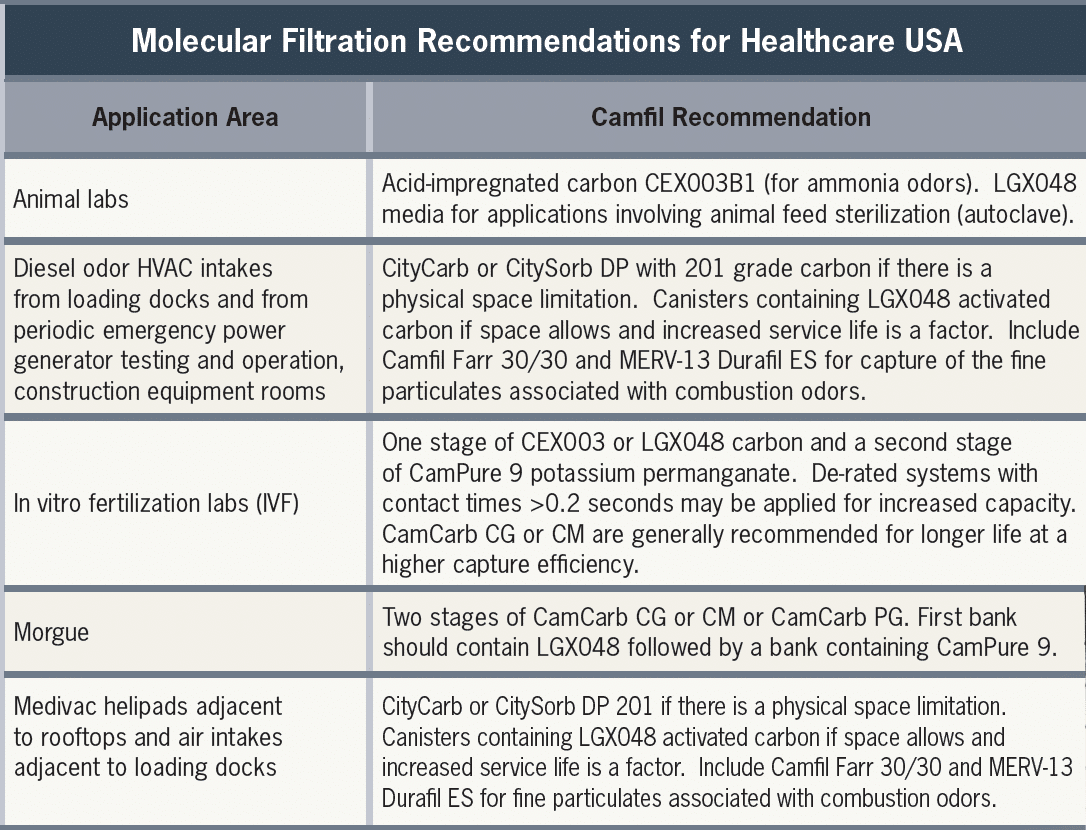
The type of air filter best suited for a healthcare facility will depend on its specific needs. Whether it’s HEPA filters for general airborne pathogen control, ULPA filters for lab environments, or molecular filters for chemical and gas removal, choosing the right filter can greatly impact the overall safety and air quality of the facility.
Considerations When Choosing an Air Filter
Ask the following questions when selecting an air filter for a hospital setting:
What Are the Specific Needs of Different Hospital Areas?
Different spaces in a hospital, such as operating rooms, ICUs, waiting areas, and outpatient centers, have varying filtration requirements. Camfil, a leading manufacturer of premium clean air solutions, recommends using MERV 8A or 9A prefilters and MERV 14A or MERV 16A final filters for hospitals to effectively remove viruses, bacteria, and other airborne particles. Additionally, HEPA filters offer an extra layer of protection.
Specialized areas like labs, pharmacies, and radiation treatment rooms might require a combination of high-efficiency MERV and HEPA filters. Molecular air filters can also be added to remove gases and odors.
How Busy is the Facility?
The volume of patient traffic can affect air quality. Emergency and waiting rooms in hospitals usually see more traffic than outpatient facilities, which have more predictable schedules and less complex procedures. Therefore, high-traffic areas may require more robust filtration systems.
What Types of Contaminants Need to be Removed?
Different filters are specialized for capturing specific types of contaminants, whether they are pathogens, microbial agents, or chemical vapors. For example, molecular air filters are effective at removing certain gases that HEPA filters can’t capture.
Is It Compatible with the HVAC System?
Choose an air filter that is compatible with the HVAC unit in the specific area. Some standard HVAC systems can’t accommodate HEPA filters due to their higher airflow resistance. Make sure the filter you choose aligns with the size of the space and works efficiently with the existing HVAC system.
Consider Sustainability
Hospitals are becoming more environmentally conscious in their operations. LEED® (Leadership in Energy and Environment Design) certification, which acknowledges acceptance of green options in building design and operation, has become a goal for new and existing healthcare facilities. One associated effort is the disposal of waste. Regulations in many areas of the country demand that air filters used in medical facilities must be red-bagged as biohazardous waste. Choosing air filters with low carbon footprints reduce waste and associated cost, while providing hospitals with more sustainable solutions.
For example, Camfil’s 30/30® Dual 9 30/30® Dual 9, Durafil® ES and Megalam® HEPA terminal panel air filters have the lowest carbon footprints in the industry. For many healthcare facilities, the Camfil premium air filters are an effective and simple way to comply with facility-wide initiatives to reduce carbon footprint. During a two-year period, a hospital using Camfil’s 5-Star premium air filters can reduce the number of filters it sends to the landfill by 56%.
Fast Facts about Hospital Filtration
HVAC systems are critical to a hospital’s infection control strategy, helping to maintain a healthy environment across various sections of the facility. Air filtration, a key component of these systems, removes airborne contaminants, enabling the recirculation of clean air.
Understanding Filter Efficiency
Choosing the right filters for your HVAC system depends on understanding their efficiency and function. While a MERV 13-rated filter may be suitable for commercial buildings, healthcare settings generally require higher-efficiency filters with at least a MERV 14 rating. These are designed to capture finer particles, like those released when a person coughs or sneezes. For specialized needs, such as removing gases or odors, molecular air filters are an effective option that HEPA filters can’t address.
The Benefits of Proper Filtration
With the appropriate type or combination of filters, healthcare facilities can significantly enhance indoor air quality. This not only helps to control the spread of diseases but also creates a better environment for patient recovery.
Maintenance Matters
Regular cleaning and replacement of filters are essential for maintaining their effectiveness and ensuring optimal indoor air quality. Also, ensure that all filter recommendations meet the required MERV standard outline in ASHRAE Standard 52.2-2021. By carefully selecting and maintaining the right filters, hospitals can play a crucial role in safeguarding both patient and staff health.
1 https://escholarship.org/uc/item/2dq7g159
2 https://www.epa.gov/report-environment/indoor-air-quality
3 https://www.politifact.com/factchecks/2015/feb/04/elizabeth-cohen/can-you-really-catch-measles-2-hours-after-infecte/
4 https://www.epa.gov/pmcourse/particle-pollution-exposure#:~:text=An%20extensive%20body%20of%20scientific%20evidence%20shows%20that,department%20visits%2C%20and%2C%20in%20some%20cases%2C%20premature%20death.
5 https://www.ashrae.org/technical-resources/bookstore/health-care-facilities-resources
6 https://www.cdc.gov/infectioncontrol/guidelines/environmental/recommendations.html
7 https://www.beckershospitalreview.com/quality/the-impact-of-patient-room-design-on-hospital-airborne-infections.html#:~:text=Our%20study%20found%2C%20however%2C%20that%20depending%20on%20the,nurses%2C%20staff%2C%20visitors%2C%20cleaners%2C%20who%20enter%20the%20room.
8 https://www.camfil.com/en-us/products/epa-hepa–ulpa-filters
9 http://www.hefilter.com/Industry-News/Wide-Applications-of-ULPA-Filter.shtml
10 https://www.camfil.com/en/insights/standard-and-regulations/iso-10121-3—2022

